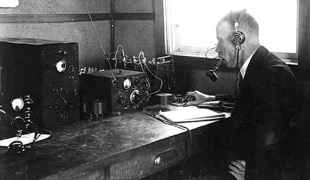Albert H. Taylor

Figure 1: Albert H. Taylor at work at the Naval Research Laboratory
Albert H. Taylor
Albert Hoyt Taylor ( ☆ January 1, 1879 in Chicago, Illinois – † December 11, 1961 in Los Angeles, California) was an American electrical engineer. Alfred Hoyt Taylor and Leo Crawford Young made the first US observations of the radio reflection phenomenon that lead to the creation of radar in the United States Navy.
Under the direction of Taylor the Naval Radio Research Laboratory made studies in radio communication. Taylor, assisted by Young, had, by 1922, pushed his experiments to frequencies of 60 megacycles by utilizing superhetrodyne receiving circuits. While working at these frequencies during the summer of that year, Taylor and Young first noted the reflection of signals from vessels passing on the Potomac River and discovered the possibility of obtaining the ranges and bearings of these vessels. This was in fact the rediscovery of radar, called by Taylor at the time “the detection of enemy ships and aircraft.” In September 1922 he addressed a letter to the Bureau of Engineering requesting authority to exploit this discovery stating that the equipment should work during darkness and low visibility as well as on a bright sunny day. (Taylor was not authorized to continue his radar research at that time.)
The technical conditions we call CW radar today, and relative movement between the radar equipment and its target was necessary in order that the latter might be detected.
Source: A. Hoyt Taylor, “Radio Reminiscences: A Half Century” (U.S. Naval Research Laboratory Report, Washington, 1948, reprinted in 1960), p. 156.
